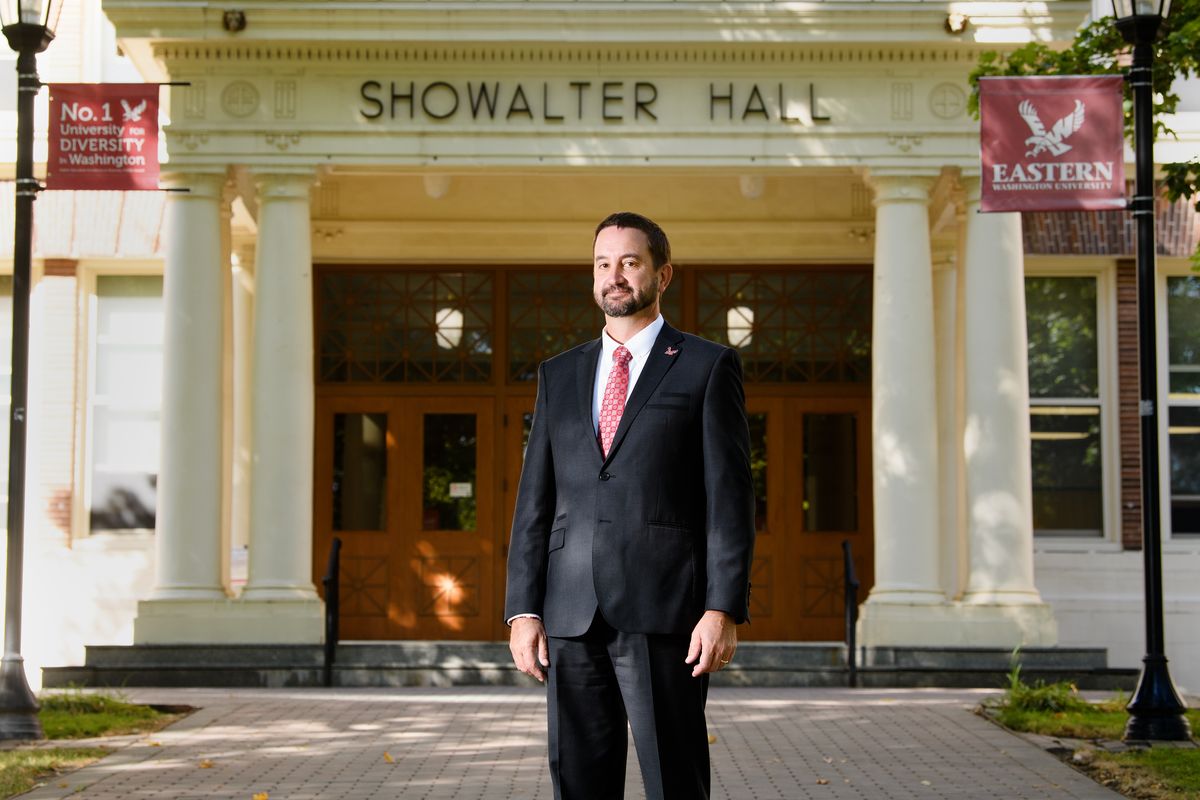EWU president’s recommendation for athletics: Make changes to stay in NCAA Division I, Big Sky Conference
David May, EWU’s interim president poses for a photo on Wednesday, Oct. 7, 2020, outside Showalter Hall on EWU’s campus in Cheney, Wash. (Tyler Tjomsland/THE SPOKESMAN-REVIEW)Buy a print of this photo
Eastern Washington University Interim President David May is recommending university athletics pull back on fully supporting some sports programs in order to continue competing in the NCAA Division I’s Big Sky Conference.
May’s recommendation to EWU’s Board of Trustees on Friday marked the latest milestone in a monthslong formal review of university athletics. The university embarked on the process amid the athletics department’s accumulated budget deficit of approximately $5.5 million since 2014.
The president’s recommendation was one of the options outlined in a report generated by The PICTOR Group, a Nevada-based consultant hired by EWU in September.
As pitched in February by Cary Groth, The PICTOR Group’s CEO, the model would fund high-profile programs – such as football and basketball – at current levels, while diminishing funding to the remaining sports.
The PICTOR report indicated that doing so could reduce the university’s expenses, mainly through the elimination of grants-in-aid to lower-tier sports programs, adoption of scheduling restrictions and possible reductions in coaching staff.
May’s recommendation did not identify particular programs to diminish in order to remain a Division I, Big Sky Conference school in, according to his report to trustees, “a manner that is sustainable to the future.”
May said those decisions would take place if the Board of Trustees decides to move forward on his recommendation.
He said leaders, including Athletics Director Lynn Hickey, would then have discussions over the summer to make those choices based on several factors, including Title IX considerations, the popularity of the sport, the number of impacted athletes and the cost savings realized with potential reductions.
Federal Title IX provisions require that men and women are provided equitable opportunities to participate in sports.
“That’s got to be centered in what we’re doing,” May said, “and in some ways, that will not dictate, but certainly guide what is possible because of roster sizes and the limited ability to manage Title IX through roster size management. It might have to be one sport rather than another simply to maintain Title IX balance.”
To cover Division I expenses, May said university leaders would have to determine a sustainable budget to remain in the Big Sky. There are few collegiate athletics programs in the U.S. that support themselves, so becoming self-sufficient is not the goal, he added.
Citing the PICTOR report, May said there is “quite a bit of headroom” for athletics to generate more revenue. He said that revenue could be coupled with “a much larger amount” of money from donors.
“If we’re going to remain Division I Big Sky athletics, and I’m making an argument very publicly that this is important for the community and beyond, I hope that community will hear what I’m saying,” May said.
With May’s recommendation in hand, Board Chair Vicki Wilson called for a special meeting in early June to consider the athletics recommendation.
“I don’t really accept that athletics exists across Washington on ‘Planet Athletics.’ Athletics is part in parcel of what we do at Eastern Washington University,” May said. “That said, if the board wanted to make a decision to go to a different level of athletics, we could implement that. I believe doing that will have a negative effect on our ability to recruit the students that our programs across the university need.”
May’s full recommendation, along with a form to submit public feedback, is available on EWU’s athletics review webpage. Trustees are accepting public feedback over the next week ahead of the board’s June decision.
‘This isn’t a popularity contest’
The PICTOR Group report outlined other options for EWU sports, including staying Division I with no changes or moving down to Division II or III. According to his report, May also considered returning EWU to the National Association of Intercollegiate Athletics (NAIA) – EWU transitioned to the NCAA in 1987 – as well as the complete elimination of athletics.
While he acknowledged the exact impacts are not quantifiable, May said he believes dropping from Division I would have negative effects.
“I think there’s a perception that if we downgraded athletics, that would upgrade academics,” he said. “What I’m trying to suggest … is I don’t think that’s the case. The literature doesn’t support that’s the case.”
May’s recommendation referenced surveys conducted through The PICTOR Group report. One such survey found 42% of 1,543 student respondents felt a comprehensive athletics program was either highly or somewhat important to them.
The university also received 180 public responses to the PICTOR report, with most respondents identifying as alumni and community members. About 135 felt EWU should remain in the Big Sky Conference, May said.
“Now we all know that this isn’t a popularity contest, and so that’s not dispositive either,” May said, “but it’s another piece of the puzzle if the strategic plan is encouraging us to be regionally impactful.”
May’s report also looked at approaches taken by similar peer institutions; published studies on the effects of athletics on universities in terms of enrollment, community-building and campus culture; and the “Flutie Effect,” the theory that a team’s strong athletics performance can boost the number of applicants to a university.
May referenced EWU website page view data from March 20, the day the men’s basketball team took on Kansas in the NCAA Tournament. The game sparked nationwide Twitter trends as the underdog Eagles sought a historic upset over the Jayhawks.
Locally, the EWU athletics website crashed that day due to high traffic volumes, May said. Elsewhere on the website, a number of other webpages – including those related to academics, application process and student life – also saw increases in page views.
“If #Eastern is trending No. 1 on Twitter for well over an hour on a Saturday, that’s media value that you can’t buy even if you have money,” May said.
Concerns persist
Given the amount of past discussion concerning athletics, Trustee Abigail Greiner asked May about how they could make a decision without knowing the specific budgetary implications.
“What I could see happening is maybe it’s three years, maybe it’s eight years, down the line, we come back, we’re having another budget problem and then it comes back to opening this whole can up,” said Greiner, the board’s student trustee, “and I don’t think the most sustainable method at that point would be to hire another group, hire PICTOR again, and to relook at athletics to keep coming back to the same idea.”
May said he aimed to make a decision based on the university’s decision, and where athletics falls into that, rather than its budget.
“I’ve been around this block a couple of times in my time here at Eastern, and the recommendation has always been based on what the budget of athletics should be and then try to build a program within a budget,” he said. “What I’m suggesting is that the basic question should be addressed on the basis of mission first.”
In a statement responding to May’s recommendation, David Syphers – vice president of the Faculty Organization – said he believes May’s decision “to punt on a real decision” ensures EWU’s next president will have to revisit the issue in just over a year.
Syphers, an associate professor of physics and astronomy who will become the Faculty Organization’s president in July, cited The PICTOR Group’s report that stated EWU would need millions in additional investment annually in order to remain a Division I Big Sky school.
“I certainly recognize that there is no additional money to give athletics, since the university is cutting in more necessary areas than this. But in that case, the kindest thing to do is to rescope their mission, and align their charge with their budget,” he said in his statement Friday.
“We could reach such alignment by transitioning to NCAA Division II or to NAIA, either of which would place us appropriately with other regional comprehensive universities in the Pacific Northwest.”
Syphers and other faculty members authored a report last year that concluded athletics has no positive impact on student enrollment, retention or recruitment.

